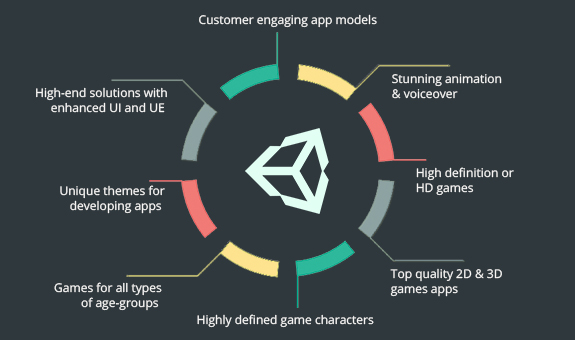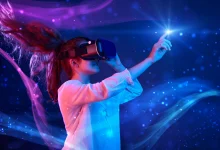Exploring the Spectrum of Augmented Reality in Gaming: Types and Applications
Types and Applications

Introduction:
Augmented reality (AR) has emerged as a transformative technology in the gaming industry, offering players immersive and interactive experiences that seamlessly blend digital content with the real world. From mobile apps to dedicated AR devices, developers have embraced various types of AR to create innovative gaming experiences that push the boundaries of traditional gameplay. In this comprehensive guide, we’ll delve into the diverse types of augmented reality in gaming, highlighting their characteristics, applications, and impact on the gaming landscape.
Marker-based AR Gaming:
Marker-based AR gaming relies on visual markers or patterns to trigger the display of digital content in the player’s environment. These markers can be printed images, QR codes, or specific patterns recognized by AR-enabled devices. When the device’s camera detects the marker, it overlays virtual objects, characters, or gameplay elements onto the real-world scene, creating immersive gaming experiences. Marker-based AR gaming is popular in mobile apps and location-based games, where players can explore their surroundings and interact with virtual content overlaid onto physical objects or locations.
Exploring the Spectrum of Marker-based AR Gaming: Types and Applications:
Marker-based augmented reality (AR) gaming represents a captivating fusion of digital and physical worlds, where players interact with virtual objects and characters overlaid onto real-world markers. This type of AR gaming leverages visual markers or patterns to trigger the display of digital content, offering players immersive and interactive experiences that blur the lines between reality and fantasy. In this comprehensive guide, we’ll delve into the diverse types of marker-based AR gaming, highlighting their characteristics, applications, and impact on the gaming landscape.
Image Recognition AR Gaming:
Image recognition AR gaming utilizes visual markers, such as printed images, QR codes, or specific patterns, to trigger the display of digital content in the player’s environment. When the AR-enabled device’s camera detects the marker, it overlays virtual objects, characters, or gameplay elements onto the real-world scene. Image recognition AR gaming is popular in mobile apps and promotional campaigns, where players can scan physical objects or images to reveal hidden content or unlock rewards.
Card-based AR Gaming:
Card-based AR gaming involves using physical cards or game pieces as markers to trigger AR experiences. Each card is associated with specific digital content or gameplay elements, which are revealed when the player points their device’s camera at the card. Card-based AR gaming is commonly used in educational apps, interactive toys, and collectible card games, where players can collect and trade physical cards to unlock virtual content or engage in multiplayer battles.
Surface-based AR Gaming:
Surface-based AR gaming utilizes flat surfaces, such as tables, floors, or walls, as markers to trigger AR experiences. Players can interact with virtual objects and characters overlaid onto the surface, manipulating them using touch or gesture controls. Surface-based AR gaming is popular in multiplayer games, collaborative experiences, and interactive installations, where players can gather around a shared surface and engage in cooperative or competitive gameplay.
Object-based AR Gaming:
Object-based AR gaming involves using physical objects or toys as markers to trigger AR experiences. Each object is associated with specific digital content or gameplay mechanics, which are activated when the player interacts with the object using their AR-enabled device. Object-based AR gaming is often used in toy-to-life games, where players can collect physical toys and bring them to life in virtual worlds, unlocking new abilities or customization options as they play.
Environmental-based AR Gaming:
Environmental-based AR gaming utilizes real-world environments, such as parks, streets, or buildings, as markers to trigger AR experiences. Players can explore their surroundings, discover hidden treasures, and interact with virtual elements overlaid onto the environment. Environmental-based AR gaming is popular in location-based games and augmented reality experiences, where players can engage with virtual content while exploring their surroundings in the real world.
Conclusion: Harnessing the Power of Marker-based AR Gaming:
In conclusion, marker-based augmented reality gaming offers a diverse range of experiences that engage players and blur the boundaries between physical and digital realities. From image recognition and card-based gaming to surface-based, object-based, and environmental-based experiences, each type of marker-based AR gaming provides players with unique opportunities for exploration, discovery, and interaction. By harnessing the power of marker-based AR gaming, developers can create immersive and engaging experiences that captivate players and push the boundaries of traditional gameplay. As AR technology continues to evolve and mature, the future of marker-based AR gaming looks brighter than ever, promising new adventures, new challenges, and new possibilities for players around the world.
Location-based AR Gaming:
Location-based AR gaming utilizes the player’s GPS, compass, and other sensors to determine their location and orientation in the real world. This type of AR gaming overlays digital content onto specific locations or points of interest, such as landmarks, buildings, or streets. Players can explore their surroundings, discover hidden treasures, and interact with virtual elements overlaid
onto the real world. Location-based AR gaming is often used in mobile games like “Pokémon GO” and “Harry Potter: Wizards Unite,” where players can capture virtual creatures or cast spells in real-world locations.
Location-based Augmented Reality (AR) Gaming: Revolutionizing Interactive Entertainment:
In recent years, the fusion of augmented reality (AR) technology with location-based gaming has birthed a new era of interactive entertainment. Location-based AR gaming, also known as geolocation AR gaming, blends the real world with virtual elements, allowing players to immerse themselves in captivating gaming experiences that unfold in their own surroundings. This innovative genre has captivated the imaginations of millions worldwide, offering a unique and engaging way to interact with both the physical and digital realms. From Pokémon GO to Ingress Prime, location-based AR gaming has captured the attention of players of all ages, transcending traditional gaming boundaries and redefining the way we perceive and engage with our environments.
Understanding Location-based AR Gaming:
At its core, location-based AR gaming leverages the GPS capabilities of mobile devices to overlay virtual content onto the real world. Players explore their physical surroundings using their smartphones or AR glasses, interacting with digital objects, characters, and events seamlessly integrated into their environment. By combining real-world maps with augmented reality technology, developers create dynamic and immersive gaming experiences that encourage players to venture outdoors, discover new locations, and engage with their surroundings in novel ways.
The Evolution of Location-based AR Gaming:
The roots of location-based AR gaming can be traced back to earlier experiments in augmented reality and mobile gaming. However, it wasn’t until the release of Niantic’s groundbreaking title, Ingress, in 2012 that the genre gained widespread attention. Ingress introduced players to a world of faction-based conflict, where they competed for control of real-world landmarks and territories using their mobile devices. The game’s innovative combination of geolocation, augmented reality, and social interaction laid the foundation for future developments in the genre.
The true explosion of location-based AR gaming came with the release of Pokémon GO in 2016. Developed by Niantic in collaboration with The Pokémon Company, Pokémon GO took the world by storm, attracting millions of players and generating unprecedented levels of engagement. By allowing players to hunt, capture, and train Pokémon creatures in the real world, Pokémon GO transformed streets, parks, and landmarks into bustling hubs of activity, as players embarked on quests to catch ’em all. The game’s phenomenal success demonstrated the immense potential of location-based AR gaming to connect people, promote physical activity, and create shared experiences in public spaces.
Since then, the genre has continued to evolve, with developers pushing the boundaries of technology and creativity to deliver increasingly immersive and engaging experiences. Games like Harry Potter: Wizards Unite and Jurassic World Alive have capitalized on popular franchises to draw in new audiences, while indie developers have experimented with innovative gameplay mechanics and storytelling techniques to create unique and compelling experiences.
The Impact of Location-based AR Gaming:
Location-based AR gaming has had a profound impact on the gaming industry and society as a whole. By encouraging players to explore their surroundings and interact with their communities, these games have fostered a sense of connection and belonging among players, turning public spaces into vibrant gaming hubs. Moreover, the genre has sparked new conversations about the potential of AR technology to enhance education, tourism, and civic engagement, opening up new opportunities for innovation and collaboration. From a business perspective, location-based AR gaming represents a lucrative market opportunity, with developers and publishers vying to create the next big hit. The success of games like Pokémon GO has demonstrated the immense revenue potential of the genre, as players flock to in-game stores to purchase virtual items and accessories. Moreover, the popularity of location-based AR gaming has spurred investments in AR technology and infrastructure, driving further innovation and growth in the industry.
Challenges and Opportunities:
Despite its success, location-based AR gaming faces several challenges, including technical limitations, privacy concerns, and issues related to safety and accessibility. Ensuring a seamless and intuitive user experience across different devices and environments remains a significant hurdle for developers, while concerns about data privacy and security continue to raise regulatory and ethical questions. Moreover, the inherently outdoor nature of location-based AR gaming can pose challenges for players in rural or isolated areas, limiting access to certain experiences and content. However, these challenges also present opportunities for innovation and growth within the industry. As technology continues to advance, developers have the opportunity to address technical limitations and improve the quality and accessibility of location-based AR gaming experiences. Moreover, by prioritizing user privacy and safety, developers can build trust and credibility with players, fostering long-term engagement and loyalty.
The Future of Location-based AR Gaming:
As we look to the future, the possibilities for location-based AR gaming are limitless. From augmented reality theme parks and interactive museum exhibits to immersive educational experiences and multiplayer adventures, the potential applications of the technology are vast and diverse. As AR hardware becomes more affordable and widespread, we can expect to see an explosion of new games and experiences that blur the lines between the physical and digital worlds, transforming how we play, learn, and connect with each other. In conclusion, location-based AR gaming represents a groundbreaking fusion of technology and entertainment that has captivated the imaginations of millions worldwide. By leveraging the power of augmented reality and geolocation technology, these games offer players a unique and immersive way to explore their surroundings, connect with others, and embark on epic adventures in the real world. As the industry continues to evolve and innovate, we can expect to see even more exciting developments on the horizon, shaping the future of gaming and interactive entertainment for years to come.
Projection-based AR Gaming:
Projection-based AR gaming involves projecting digital content onto physical surfaces, such as walls, floors, or objects, using projectors or other display technologies. This type of AR gaming creates interactive experiences where players can manipulate or interact with virtual objects directly on the surface they are projected onto. Projection-based AR gaming is popular in interactive installations, exhibitions, and theme park attractions, where players can engage with immersive and dynamic content in physical spaces.
Projection-based Augmented Reality Gaming: Redefining Interactive Entertainment:
In the realm of augmented reality (AR), projection-based AR gaming stands out as a fascinating and innovative approach to blending virtual elements with the real world. Unlike traditional AR experiences that rely on handheld devices or wearable technology, projection-based AR gaming utilizes projectors to overlay digital content directly onto physical surfaces, creating immersive and interactive environments that captivate players’ imaginations. This emerging genre of gaming offers a unique and compelling way to engage with digital content, transforming ordinary spaces into dynamic playgrounds where players can explore, interact, and compete in entirely new ways.
Understanding Projection-based AR Gaming:
Projection-based AR gaming leverages projectors to cast virtual images, animations, and interactive elements onto real-world surfaces such as walls, floors, and tables. Players interact with these projections using gestures, touch, or other input methods, immersing themselves in dynamic and responsive gaming experiences that unfold in their own surroundings. Whether it’s battling virtual enemies in a living room, solving puzzles in a classroom, or creating digital art in a public space, projection-based AR gaming offers endless possibilities for creativity and exploration.
The Evolution of Projection-based AR Gaming:
The roots of projection-based AR gaming can be traced back to early experiments in interactive art and installation design. Artists and technologists have long been fascinated by the idea of blending digital and physical worlds, using projectors to create immersive and interactive experiences that transcend traditional boundaries. However, it wasn’t until recent years that projection-based AR gaming began to gain traction as a mainstream form of entertainment, thanks to advancements in projection technology, computer vision, and game design.One of the pioneering examples of projection-based AR gaming is “Ahrrrr!” developed by the Augmented Environments Lab at Georgia Tech. Released in 2008, Ahrrrr! combined augmented reality with tangible gameplay elements, allowing players to interact with virtual objects projected onto a physical tabletop. The game demonstrated the potential of projection-based AR gaming to create rich and engaging experiences that blend physical and digital elements seamlessly. Since then, developers and researchers have continued to explore the possibilities of projection-based AR gaming, experimenting with new technologies and design techniques to push the boundaries of interactive entertainment. From large-scale installations at museums and festivals to smaller-scale experiences in homes and classrooms, projection-based AR gaming has found applications in a wide range of contexts, captivating audiences of all ages and backgrounds.
The Impact of Projection-based AR Gaming:
Projection-based AR gaming has had a profound impact on the gaming industry and beyond, opening up new avenues for creativity, collaboration, and expression. By leveraging the physical space as a canvas for digital content, these games encourage players to explore and interact with their surroundings in novel ways, fostering creativity, imagination, and social interaction. Moreover, projection-based AR gaming has the potential to break down barriers between players and create shared experiences that transcend physical location, bringing people together in virtual worlds that exist in the spaces where they live, work, and play. From a technological standpoint, projection-based AR gaming has pushed the boundaries of what’s possible with projection technology, driving innovation in areas such as computer vision, real-time rendering, and interactive storytelling. As projectors become more affordable, portable, and versatile, we can expect to see even more exciting developments in the field, with new games and experiences that push the boundaries of immersion and interactivity.
Challenges and Opportunities:
Despite its potential, projection-based AR gaming faces several challenges, including technical limitations, scalability issues, and the need for accessible and intuitive interfaces. Achieving seamless integration between physical and digital elements can be challenging, especially in environments with complex lighting conditions or uneven surfaces. Moreover, creating compelling gameplay experiences that leverage the unique affordances of projection technology requires careful design and iteration, as developers navigate the constraints of space, technology, and user experience. However, these challenges also present opportunities for innovation and growth within the industry. As technology continues to advance, developers have the opportunity to address technical limitations and improve the quality and accessibility of projection-based AR gaming experiences. Moreover, by collaborating with artists, educators, and other stakeholders, developers can explore new ways to leverage projection technology for creative expression, learning, and social impact.
The Future of Projection-based AR Gaming:
As we look to the future, the possibilities for projection-based AR gaming are limitless. From interactive art installations and immersive theater experiences to educational games and collaborative workspaces, projection-based AR gaming has the potential to transform how we engage with digital content in the physical world. As projection technology continues to evolve and become more accessible, we can expect to see even more exciting developments in the field, with new games and experiences that push the boundaries of immersion, creativity, and interactivity. In conclusion, projection-based AR gaming represents a groundbreaking fusion of technology and creativity that has the power to redefine how we interact with digital content in the physical world. By leveraging projection technology to overlay virtual elements onto real-world surfaces, these games offer players a unique and immersive way to explore, create, and play in the spaces where they live, work, and play. As the industry continues to evolve and innovate, we can expect to see even more exciting developments on the horizon, shaping the future of gaming and interactive entertainment for years to come.
Wearable AR Gaming:
Wearable AR gaming utilizes AR-enabled devices like smart glasses or headsets to overlay digital content onto the player’s field of view. These devices provide players with immersive visuals, spatial audio, and hands-free interaction, enhancing the gaming experience and enabling new forms of gameplay. Wearable AR gaming is still in its early stages but holds great potential for creating immersive and engaging gaming experiences that seamlessly integrate with the player’s surroundings.
Wearable AR Gaming: The Next Frontier in Immersive Entertainment:
Wearable augmented reality (AR) gaming represents a revolutionary leap forward in interactive entertainment, bringing virtual worlds to life in ways previously unimaginable. By integrating AR technology directly into wearable devices such as smart glasses, headsets, and even clothing, developers are ushering in a new era of gaming that blurs the lines between the digital and physical worlds. From epic adventures in sprawling open-world environments to intimate experiences that unfold right before your eyes, wearable AR gaming offers unparalleled levels of immersion and interactivity, transforming the way we play and experience games.
Understanding Wearable AR Gaming:
At its core, wearable AR gaming leverages advanced sensor technology, high-resolution displays, and powerful processors to overlay virtual elements onto the wearer’s field of view. Unlike traditional AR experiences that require users to hold up a smartphone or tablet, wearable devices allow for hands-free interaction, freeing players to move and explore their surroundings without interruption. Whether it’s battling enemies, solving puzzles, or collaborating with friends, wearable AR gaming offers a seamless and intuitive way to engage with virtual content in the real world.
The Evolution of Wearable AR Gaming:
The roots of wearable AR gaming can be traced back to early experiments in head-mounted displays and wearable computing. Researchers and enthusiasts have long been fascinated by the idea of augmenting human perception with digital information, exploring concepts such as heads-up displays (HUDs), augmented reality goggles, and wearable sensors. However, it wasn’t until recent years that wearable AR gaming began to gain traction as a mainstream form of entertainment, thanks to advancements in hardware technology, software development, and user experience design.One of the watershed moments for wearable AR gaming came with the release of Google Glass in 2013. Although initially met with skepticism and controversy, Google Glass demonstrated the potential of wearable AR technology to enhance everyday experiences, from navigation and communication to photography and gaming. While Google Glass ultimately failed to gain widespread adoption, it laid the groundwork for future developments in the field, inspiring a new generation of innovators to explore the possibilities of wearable AR gaming.
Since then, developers and manufacturers have continued to push the boundaries of wearable AR gaming, releasing a variety of devices and experiences designed to appeal to different audiences and use cases. Companies like Magic Leap, Microsoft, and Oculus have invested heavily in AR and VR technology, releasing headsets and platforms that promise to revolutionize gaming and entertainment. From standalone devices like the Magic Leap One to tethered headsets like the Oculus Rift S, there’s no shortage of options for gamers looking to experience AR in a wearable form factor.
The Impact of Wearable AR Gaming:
Wearable AR gaming has had a profound impact on the gaming industry and beyond, opening up new possibilities for creativity, collaboration, and social interaction. By seamlessly blending virtual and physical elements, these games offer players a level of immersion and interactivity that was previously unimaginable, allowing them to experience digital worlds in ways that feel natural and intuitive. Moreover, wearable AR gaming has the potential to transcend traditional gaming boundaries, reaching audiences beyond hardcore gamers and appealing to a wide range of demographics and interests.From a technological standpoint, wearable AR gaming has driven innovation in areas such as display technology, sensor technology, and user interface design. Companies are constantly pushing the boundaries of what’s possible with wearable devices, experimenting with new form factors, input methods, and interaction paradigms to create more immersive and engaging experiences. As hardware continues to improve and become more affordable, we can expect to see even more exciting developments in the field, with new devices and experiences that push the boundaries of what’s possible with AR technology.
Challenges and Opportunities:
Despite its potential, wearable AR gaming faces several challenges, including technical limitations, user experience design, and social acceptance. Achieving seamless integration between virtual and physical elements can be challenging, especially in dynamic or unpredictable environments. Moreover, designing intuitive and accessible user interfaces for wearable devices requires careful consideration of factors such as ergonomics, usability, and accessibility. Finally, there are still lingering concerns around privacy, security, and social acceptance, as wearable devices raise questions about surveillance, data collection, and social etiquette.However, these challenges also present opportunities for innovation and growth within the industry. By addressing technical limitations and improving user experience design, developers can create more compelling and immersive experiences that appeal to a wider audience. Moreover, by fostering collaboration between developers, manufacturers, and stakeholders, the industry can work together to address concerns around privacy, security, and social acceptance, building trust and credibility with users and communities.
The Future of Wearable AR Gaming:
As we look to the future, the possibilities for wearable AR gaming are limitless. From epic adventures in sprawling open-world environments to intimate experiences that unfold right before your eyes, wearable AR gaming has the potential to transform how we play and experience games. As hardware continues to improve and become more affordable, we can expect to see even more exciting developments in the field, with new devices and experiences that push the boundaries of what’s possible with AR technology. In conclusion, wearable AR gaming represents a revolutionary leap forward in interactive entertainment, offering unparalleled levels of immersion and interactivity that blur the lines between the digital and physical worlds. By seamlessly blending virtual and physical elements, these games offer players a level of immersion and interactivity that was previously unimaginable, allowing them to experience digital worlds in ways that feel natural and intuitive. As the industry continues to evolve and innovate, we can expect to see even more exciting developments on the horizon, shaping the future of gaming and entertainment for years to come.
Mixed Reality (MR) Gaming:
Mixed reality (MR) gaming combines elements of both virtual reality (VR) and augmented reality (AR) to create immersive gaming experiences that blend digital and physical worlds. In MR gaming, players interact with virtual objects and characters overlaid onto the real world, while also having the ability to manipulate and interact with physical objects in their environment. MR gaming offers a unique blend of immersion and interactivity, allowing players to experience games in new and innovative ways.
Conclusion: Embracing the Diversity of AR Gaming:
In conclusion, the diverse types of augmented reality in gaming offer unique opportunities for innovation, creativity, and immersion. From marker-based AR to location-based AR, projection-based AR, wearable AR, and mixed reality gaming, each type of AR gaming provides players with a unique and engaging experience that seamlessly integrates digital content with the real world. By embracing the diversity of AR gaming and exploring its potential applications, developers can create immersive and interactive gaming experiences that captivate players and push the boundaries of traditional gameplay. As AR technology continues to evolve and mature, the future of AR gaming looks brighter than ever, promising new adventures, new challenges, and new possibilities for players around the world.











